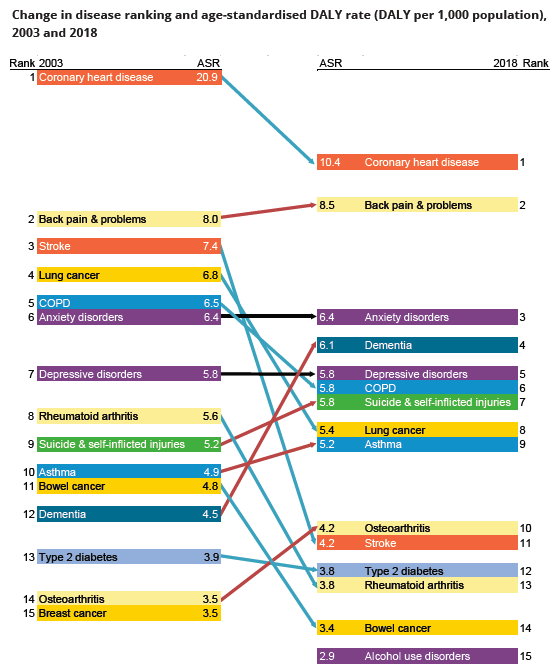Musculoskeletal problems, especially back pain, remain a significant contributor to the total burden of disease in Australia – but the burden of rheumatoid arthritis has fallen by a third in recent years.

According to the latest Australian Burden of Disease Study from the Australian Institute of Health and Welfare, the five leading disease groups in 2018 were cancer, musculoskeletal conditions, cardiovascular diseases, mental health & substance use disorders, and injuries.
There had been improvements overall since 2003, with a reduction in total burden and fatal burden but not non-fatal burden as measured by disability-adjusted life years (DALYs).
“Musculoskeletal conditions caused substantial total burden in Australians aged from 10 to 84, more so for females than males,” the study said.
“In particular, women aged 35–74 experienced 21% of their total burden from these conditions, and for men of the same age group, 14%.”
Musculoskeletal conditions were the leading cause of total burden for adults 45–74 years of age.
“In particular, this disease group was the predominant cause of non-fatal burden in Australians aged 50–84, contributing to almost one-third of the non-fatal burden for this age group.”
In terms of risk factors, overweight and obesity contributed to a range of disease groups, including 8.9% for musculoskeletal conditions.
For specific diseases, back pain and problems as well as osteoarthritis increased in DALY per 1,000 between 2003 and 2018 (7.3% and 20% rise respectively.)
“On the other hand, burden reduced for rheumatoid arthritis from 5.5 YLD per 1,000 population to 3.7 (32% decrease).”
ARA President Professor Catherine Hill told the limbic that the data was interesting.
She said the reduction in RA was likely due to improved RA management including recognition of the need for earlier DMARD initiation, improved therapeutics including biologics and treat to target strategies.
As well, a reduction in cigarette smoking may have contributed to the reduction in RA.
“The increase in OA and back pain is likely due to aging of the population and increasing obesity,” she said.
Professor Hills added there were large socioeconomic differences in each of these diseases with lower SES associated with more disability.
State divides
Back pain & problems was the leading cause of total disease burden for the first time in the ACT since 2011.
“Notably, although back pain & problems was in second place for Victoria, Queensland and Western Australia in 2011 and in 2018, the gap between it and the leading cause (coronary heart disease) has narrowed.”
Osteoarthritis ranked in the leading 10 causes for a state or territory in Victoria, Tasmania and Australian Capital Territory while rheumatoid arthritis ranked for Tasmania.